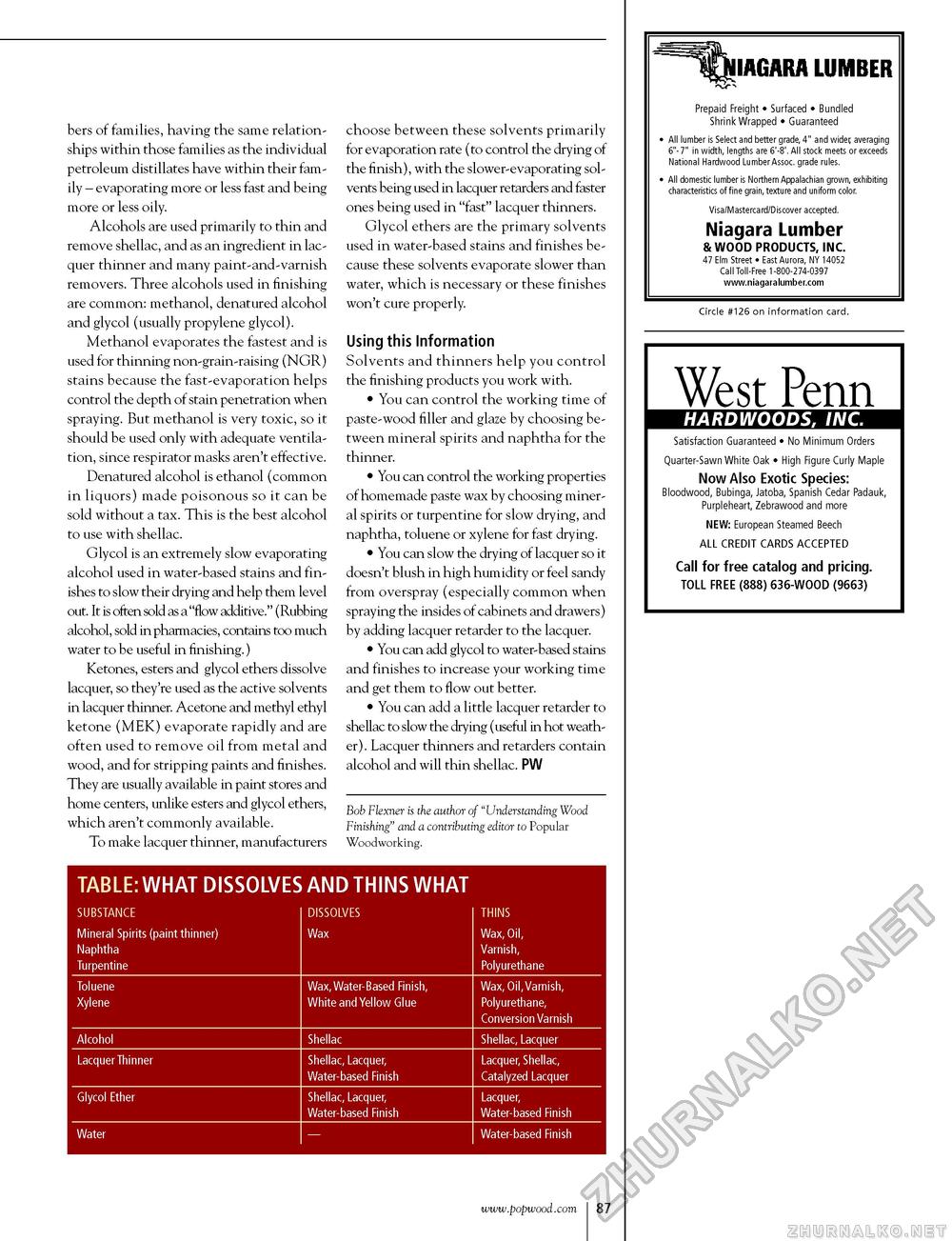Popular Woodworking 2002-04 № 127, страница 85
bers of families, having the same relationships within those families as the individual petroleum distillates have within their family - evaporating more or less fast and being more or less oily. Alcohols are used primarily to thin and remove shellac, and as an ingredient in lacquer thinner and many paint-and-varnish removers. Three alcohols used in finishing are common: methanol, denatured alcohol and glycol (usually propylene glycol). Methanol evaporates the fastest and is used for thinning non-grain-raising (NGR) stains because the fast-evaporation helps control the depth of stain penetration when spraying. But methanol is very toxic, so it should be used only with adequate ventilation, since respirator masks aren't effective. Denatured alcohol is ethanol (common in liquors) made poisonous so it can be sold without a tax. This is the best alcohol to use with shellac. Glycol is an extremely slow evaporating alcohol used in water-based stains and finishes to slow their drying and help them level out. It is often sold as a "flow additive." (Rubbing alcohol, sold in pharmacies, contains too much water to be useful in finishing.) Ketones, esters and glycol ethers dissolve lacquer, so they're used as the active solvents in lacquer thinner. Acetone and methyl ethyl ketone (MEK) evaporate rapidly and are often used to remove oil from metal and wood, and for stripping paints and finishes. They are usually available in paint stores and home centers, unlike esters and glycol ethers, which aren't commonly available. To make lacquer thinner, manufacturers choose between these solvents primarily for evaporation rate (to control the drying of the finish), with the slower-evaporating solvents being used in lacquer retarders and faster ones being used in "fast" lacquer thinners. Glycol ethers are the primary solvents used in water-based stains and finishes because these solvents evaporate slower than water, which is necessary or these finishes won't cure properly. Using this Information Solvents and thinners help you control the finishing products you work with. • You can control the working time of paste-wood filler and glaze by choosing between mineral spirits and naphtha for the thinner. • You can control the working properties of homemade paste wax by choosing mineral spirits or turpentine for slow drying, and naphtha, toluene or xylene for fast drying. • You can slow the drying of lacquer so it doesn't blush in high humidity or feel sandy from overspray (especially common when spraying the insides of cabinets and drawers) by adding lacquer retarder to the lacquer. • You can add glycol to water-based stains and finishes to increase your working time and get them to flow out better. • You can add a little lacquer retarder to shellac to slow the drying (useful in hot weather). Lacquer thinners and retarders contain alcohol and will thin shellac. PW Bob Flexner is the author of "Understanding Wood Finishing" and a contributing editor to Popular Woodworking. IAGARA LUMBER Prepaid Freight • Surfaced • Bundled Shrink Wrapped • Guaranteed • All lumber is Select and better grade, 4" and wider averaging 6"-7" in width, lengths are 6'-8'. All stock meets or exceeds National Hardwood Lumber Assoc. grade rules. All domestic lumber is Northern Appalachian grown, exhibiting characteristics of fine grain, texture and uniform color. Visa/Mastercard/Discover accepted. Niagara Lumber & WOOD PRODUCTS, INC. 47 Elm Street • East Aurora, NY 14052 Call Toll-Free 1-800-274-0397 www.niagaralumber.com Circle #126 on information card. West Penn HARDWOODS, INC. Satisfaction Guaranteed • No Minimum Orders Quarter-Sawn White Oak • High Figure Curly Maple Now Also Exotic Species: Bloodwood, Bubinga, Jatoba, Spanish Cedar Padauk, Purpleheart, Zebrawood and more NEW: European Steamed Beech ALL CREDIT CARDS ACCEPTED Call for free catalog and pricing. TOLL FREE (888) 636-WOOD (9663) TABLE: WHAT DISSOLVES AND THINS WHAT
|






